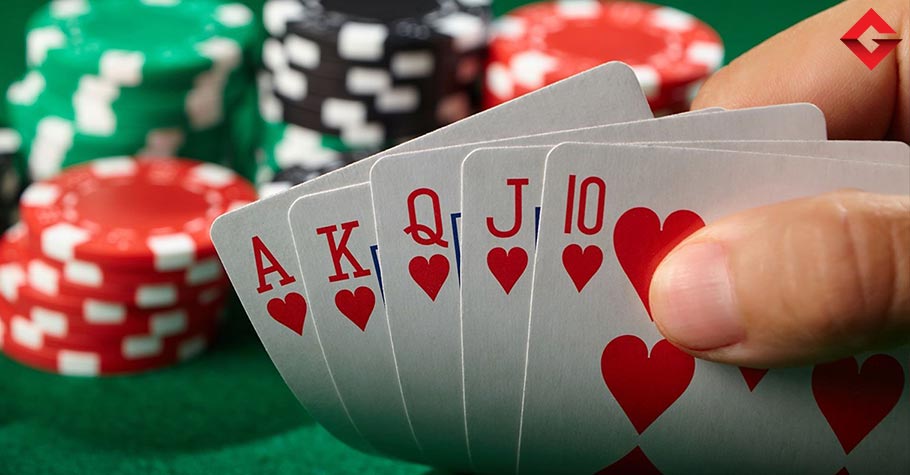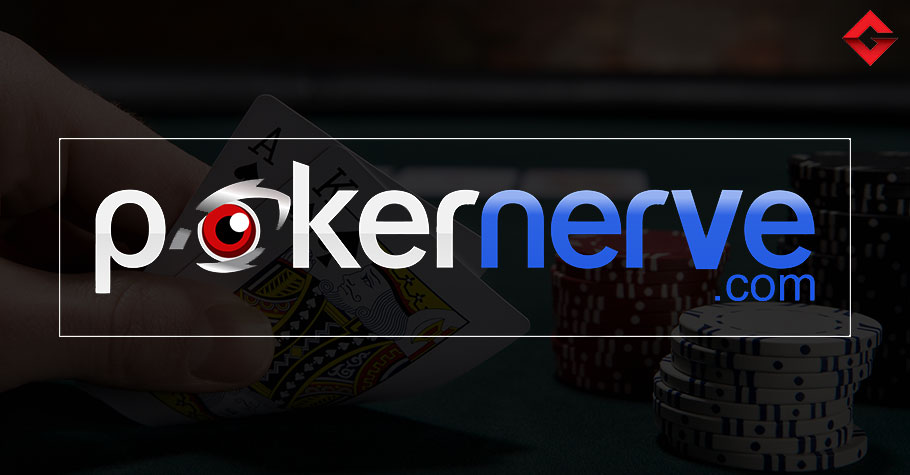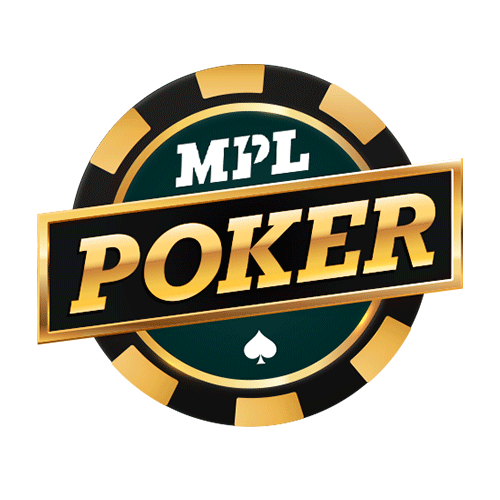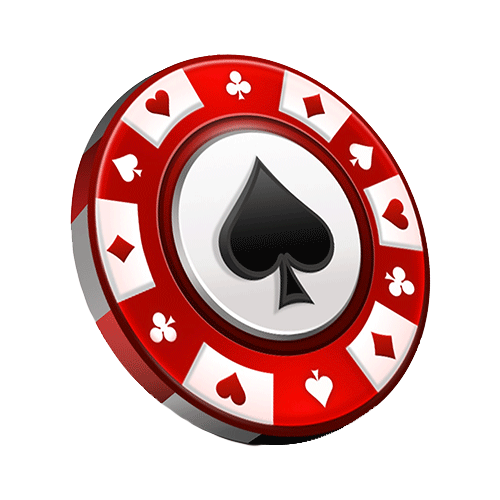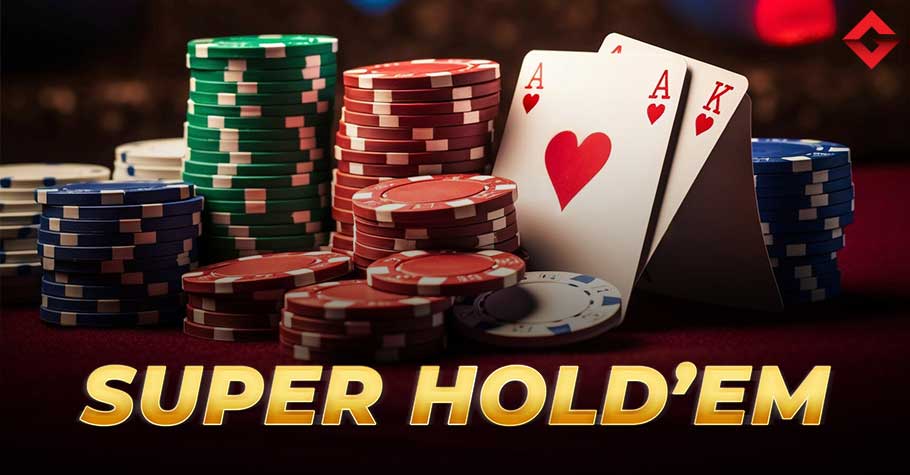 Poker
Poker
Super Hold’em For Beginners
Super Hold’em Poker is a captivating blend of two popular card games, Texas Hold’em and Teen Patti. This refreshing variant of poker offers players an exhilarating gameplay experience with its unique rules and exciting twists, available exclusively on cash tables.
What is Super Hold’em?
If you’re already familiar with Texas Hold’em, then Super Hold’em Poker will be a breeze for you. The rules are easy and straightforward, mirroring those of Texas Hold’em games. Super Hold’em is a thrilling poker variant that combines elements of Texas Hold’em and Teen Patti. In this game, players are dealt three hole cards instead of the traditional two hole cards in Texas Hold’em. To form a winning hand, players must use at least one of their hole cards in combination with the community cards on the table. This extra hole card adds a new level of strategy and excitement to the game, offering players more possibilities for creating strong hands.
Super Hold’em follows a similar betting structure to Texas Hold’em, with four rounds of betting (pre-flop, flop, turn, and river) where players can choose to call, raise, check or fold based on the strength of their hand and strategy. The game culminates in a showdown where the remaining players reveal their hands to determine the winner.
For the first time in India, introducing Super Hold’em, jaha ek extra hole card se milega extra fun and extra thrill. Join the action now. #Poker #PokerBaazi #Baazigar #SkillGame #NewGameFormat #SuperHoldem #YouHoldTheCards pic.twitter.com/aBE9QZVeAm
— PokerBaazi (@PokerBaazi) August 12, 2023
Limitless Possibilities With A Twist
The twist in Super Hold’em lies in the extra hole card, offering players limitless possibilities to create winning hands. This additional card adds an element of curiosity and adrenaline, surpassing that of regular Texas Hold’em. Whether you’re a seasoned poker pro or a recreational player, Super Hold’em promises a poker experience like no other.
ALSO READ: Dominating The Field: Strategies For Excelling In Poker Bounty Tournaments
Super Hold’em On Non-Paired Boards
One of the most intriguing aspects of Super Hold’em is its potential for high-ranking hands on non-paired boards. For example, players can achieve a full house or even quads without a paired board, unlocking incredible potential for big wins.
Super Hold’em is now the preferred choice for enthusiasts seeking high-octane poker action. Whether you’re a seasoned Texas Hold’em player or looking for a refreshing twist, Super Hold’em Poker offers a familiar yet exciting variation of your favourite poker game.
Gameplay In Super Hold’em Poker
Super Hold’em, also known as Super Texas Hold’em, follows a betting procedure consisting of four rounds, mirroring the traditional Texas Hold’em structure. These rounds are:
Pre-flop:
The action begins with blinds. The two players to the dealer’s left post the big blind and small blind, respectively. The big blind is 2x the small blind as per game structure. This ensures there’s already some money in the pot for players to compete for. Players can then choose to call (match the previous bet), raise (increase the bet), or fold (give up the hand) based on their hole cards. If no new bets have been placed, players can ‘check’ to pass the action to the next player without adding more chips to the pot.
Flop:
After the pre-flop betting, the dealer reveals the first three community cards on the board. These cards are visible to all players and can be used by everyone to form their best five-card hand. Players evaluate their hands and decide whether to call, raise, or fold based on the new information from the flop. The ‘check’ option is available again if no new bets have been made.
Turn:
The turn is the third round of betting, where the dealer introduces the fourth community card. Betting options remain the same, and players can check until a new bet is placed.
River:
The final community card, known as the river, is revealed by the dealer. This card completes the five-card community board. Players make their final bets based on their complete five-card hand, combining their hole cards with the community cards.
Showdown:
Once all five community cards are on the table, the remaining players reveal their hands in a showdown. The player with the best five-card hand wins the pot. If all players except one fold, the remaining player wins the pot uncontested. This concludes a round of Super Hold’em Poker.
Tips For Beginners In Super Hold’em
Tip #1: Play a Tight Range of Hands and Be Aggressive
In No Limit Texas Hold’em, it’s crucial to be selective about the hands you play before the flop. Even the most skilled players have a limit to how many starting hands they should play. Playing too many hands can deplete your chip stack quickly, unless luck is consistently on your side.
Having a solid preflop strategy is the quickest way to enhance your overall performance. While it’s relatively easy to develop strong preflop ranges (such as by using preflop charts), the real challenge lies in sticking to them. It’s essential to avoid impatience and refrain from playing hands that aren’t worth it.
The best approach is to play a tight selection of strong or potentially strong hands, and to play them aggressively. Aggressive play, even with hands like 7♠ 6♠ or 5♥ 5♣, helps disguise the true strength of your hand from your opponents.
By raising, you make it difficult for opponents to gauge whether you hold a monster hand like A-A or A-K, or a more moderate hand like 7-6. This unpredictability makes you a formidable player at the table. Remember, a tight and aggressive style often leads to success in poker.
Note: A solid preflop strategy is essential for winning at poker. Our free Preflop Guide provides eight easy-to-understand charts and vital tips to help you play like a professional before the flop. Get your copy now!
Tip #2: Don’t Be The First One To Limp
In the game of poker, limping (simply calling the big blind before the flop) as the first player to enter a pot is generally considered a poor strategy. There are two primary reasons why this move is discouraged:
- You can’t win the pot before the flop as you could if you had raised.
- By limping, you offer players behind you very attractive pot odds, increasing the likelihood of facing multiple opponents and decreasing your chances of winning the pot.
The only situation where limping can be acceptable is when at least one other player has already limped. This strategy, known as over-limping, can sometimes be advantageous because it offers you great pot odds to join the action, potentially allowing you to hit a strong hand on the flop.
Tip #3: Use Semi-Bluffs Aggressively With Drawing Hands
Effective bluffing is a key skill in successful poker play. However, bluffing without a clear strategy can quickly deplete your chip stack. To bluff effectively, it’s important to consider the cards you have and use them to determine whether bluffing is the right move.
One of the most effective bluffing strategies is the semi-bluff, which involves betting or raising with a hand that has the potential to improve to the best hand on a later street. This includes hands with straight draws, flush draws, or even just one or two overcards to the board.
Think of these drawing hands as a backup plan in case your bluff is called. If you hit your draw, you not only improve your hand but also have a strong chance of winning the pot, even if your bluff is detected. Poker players often refer to these hands as “semi-bluffs” due to their potential to improve beyond the bluff. To learn more about semi-bluffing, you can find additional information here.
For beginners, bluffing with weak or no hands before the river is generally not recommended, with one exception that I’ll discuss shortly.
Tip #4: Aggressively Bet Your Strong Hands To Maximize Pot And Earnings
It’s disappointing to see a player with a nut flush checking three times, only to awkwardly reveal their strong hand when their opponent checks back on the river. Overly cautious play, known as slow-playing, is a common mistake among players who fear driving their opponents out of the pot when holding a strong hand.
In most situations, it’s wise to bet your strong hands to increase the pot size and safeguard your equity. This doesn’t mean you should always bet or raise your strong hands post-flop. You might choose to check your strong hands if:
- The likelihood of being outdrawn is low.
- Few scare cards exist that could prevent you from earning more on later streets.
- Your opponent’s range mainly consists of hands with no potential to win at showdown.
However, when unsure, opt to bet (or check-raise if you didn’t initiate the betting pre-flop). While it can be disappointing if your opponent folds, it’s far better than risking being outdrawn or missing out on potential winnings.
Tip #5: Defend Your Big Blind Selectively
The big blind is a unique position because you’ve already invested one big blind into the pot. Consequently, when facing a raise from the big blind, you often have better pot odds than players in other positions—a sort of discount.
Due to this discount and the advantage of acting last pre-flop, you can profitably call with more hands than if you were in a different position. This doesn’t mean you should call raises with weak hands like 9♠ 5♦, but borderline hands such as K♣ 9♦ and Q♥ 6♥ become playable in many scenarios.
The extent to which you should defend your big blind depends on several factors, including:
- The raiser’s position (play tighter against early positions and looser against late positions).
- The number of players in the hand (play tighter when one or more players have already called the raise).
- The size of the raise (tighten your play with larger bet sizes and loosen with smaller ones).
- Stack sizes (play fewer speculative hands and prioritize high-card strength when short-stacked).
While other factors, like your opponent’s post-flop betting frequency, are also important, these four are the primary considerations.
Tip #6: Fold When Uncertain
The biggest difference between a mediocre and a professional player is the professional’s ability to fold a strong hand like top pair when they believe they’re beaten.
While this may seem straightforward, it’s challenging in practice, partly due to our innate curiosity and desire to win. Folding means relinquishing the opportunity to win the pot and satisfying our curiosity about our opponent’s hand.
Calling too frequently and in inappropriate situations is the second quickest route to losing at poker, following ineffective bluffs. When unsure whether to call or fold against a bet or raise, it’s advisable to fold.
Pro Tip: Keep a record of hands where you fold in such situations. Reviewing or discussing these hands can significantly enhance your skills and fill any gaps in your poker knowledge.
Tip #7: Exploit Opponent Weakness With Aggressive Betting
Players often fail to check with hands that could withstand multiple bets, leaving them with relatively weak hands when they do check. This tendency creates an opportunity for aggressive bluffing, especially in heads-up pots where opponents exhibit significant weakness by checking on the flop and turn.
In such situations, employ an aggressive bluffing strategy to capitalize on their weakness. Besides betting with typical semi-bluffs, consider betting purely as a bluff with certain hands that have no value, particularly those with strong blocker effects.
Tip #8: Build Your Stack Early In Tournaments Through Aggressive Play
The early stages of poker tournaments require a different strategy than stack preservation. Many players mistakenly focus on survival at the start, but to finish in the money, you’ll likely need to double or triple your starting stack, if not more. Instead of playing defensively, aim to play solid, aggressive poker to accumulate chips for a deep tournament run.
Only adopt a more survival-oriented style if you find yourself short-stacked near the money bubble or a pay jump. This strategic shift is crucial for maximizing your chances of cashing in the tournament.
Tip #9: Play Poker When You’re Mentally Ready
Whether poker is a hobby or a profession, it should be an enjoyable experience. A poker player’s performance will be at its best when he/she is focused on the game. Therefore, it’s important to only play poker when you feel mentally prepared and in a good mood.
If you start to feel frustrated, fatigued, or angry during a session, consider taking a break or ending the session altogether. This decision can prevent you from making costly mistakes due to emotional play.
Pro Tip: Before starting a poker session, imagine the scenario of going all-in and losing your entire stack on the first hand. If this thought doesn’t bother you and you feel prepared for such an outcome, you’re likely in the right mindset to play your best game. However, if the idea of losing a buy-in right away is too distressing, it might be wise to reconsider playing until you’re mentally ready.
Tip #10: Look For Games With Weaker Players For Better Odds
“If you can’t spot the sucker in your first half hour at the table, then you are the sucker.” This popular quote from the blockbuster film Rounders (1998) is relevant even today. To excel at poker, you must play against opponents who are less skilled than you.
Imagine you’re the 9th best poker player globally; you’d be the strongest player at nearly any table. But if you sit down with the top 8 players, you’re at a disadvantage. Always aim to play where your chances of winning are highest. This requires checking your ego at the door.
Generally, to have a profitable win-rate, you need to outperform at least half the players at the table. To maximize profits, seek out games with weaker opponents.
Checklist to spot a lucartive poker game:
- Regular limpers: Look for players who consistently enter pots with a call rather than a raise.
- Multiway pots: Games where many players are staying in hands to see the flop indicate looser, weaker competition.
- Re-raises: Rare re-raises suggest passive play, while frequent re-raises can indicate aggressive but predictable opponents.
A game meeting 2 or more of these criteria is likely profitable. If none apply, consider finding a more lucrative table.
When playing online, leverage the table statistics provided by most sites. Choose tables with a high average pot size and a high percentage of players seeing the flop. This strategy is often overlooked by new players still mastering the rules.
Conclusion
Super Hold’em Poker promises an extraordinary poker experience filled with excitement and the opportunity to win big. If you wish to play Super Hold’em Poker games, check out CardBaazi’s Super Hold’em cash games across low, mid and high stakes. Click here to sign up.
More cards, more chances to win!
Try the all-new poker variant, Super Hold’em where you can make your poker hand using just one hole card. Play Now.#CardBaazi #AsliIndiaKaRMG #SuperHoldem #Poker pic.twitter.com/qATsFwSz54— CardBaazi (@CardBaazi) September 14, 2023
For more news and updates, keep reading GutshotMagazine.com. Follow us on Facebook, Instagram, Twitter, and Telegram.

With a Masters Degree in Journalism and Communication, Mrinal Gujare currently is cruising through an exciting genre of writing and editing at Gutshot Magazine. Apart from being an Editor, Mrinal is an avid reader and a former contemporary dancer. She is also perennially hungry for intriguing scoops from across the globe. No holds barred is the rule Mrinal follows in life.
More News
Top 15 Poker Rooms
-
WPT Global
Grab your welcome offer
Offer: 100% of your deposit back up to $3,000 Register -
PokerDangal
Sign up with code GUTSHOT1
Offer: Get 100% GST discount on deposits Register -
Natural8 India
Sign-up with Gutshot
Offer: Get extra 28% on all deposits Register -
Spartan Poker
Sign-up with referral code AFFGSMAG
Offer: FTD 50% Bonus Money up to ₹20K. Deposit code ‘ALLIN50’ Register -
Junglee Poker
Sign-up and get bonus
Offer: Up to ₹50,000* Register -
Calling Station
Sign-up with promo code 'AFFCSGUT'
Offer: 30% FTD bonus with code FTD30 Register -
WinZo Poker
Daily Winnings Up To ₹40 Crore!
Offer: Get ₹550 Joining Bonus For Free Register -
Stake Poker
Welcome bonus
Offer: 200% up to ₹120,000 Register
Newsletter
Thank you for subscribing to our newsletter.
This will close in 20 seconds







